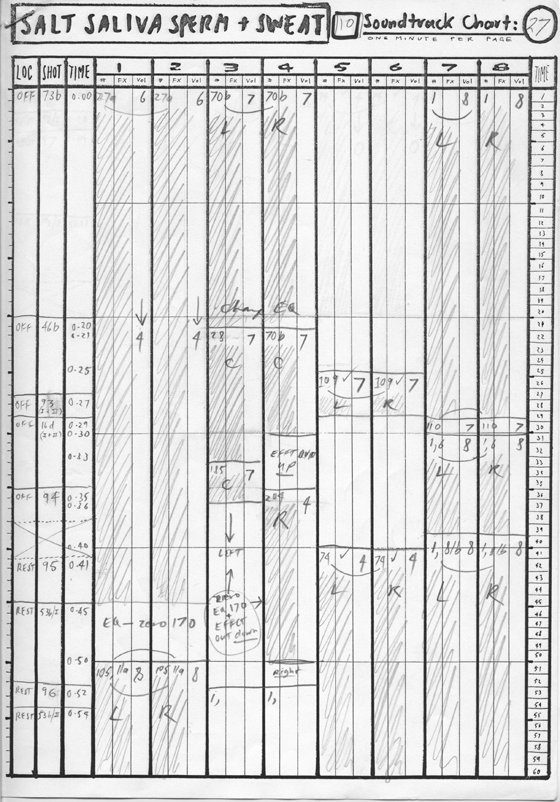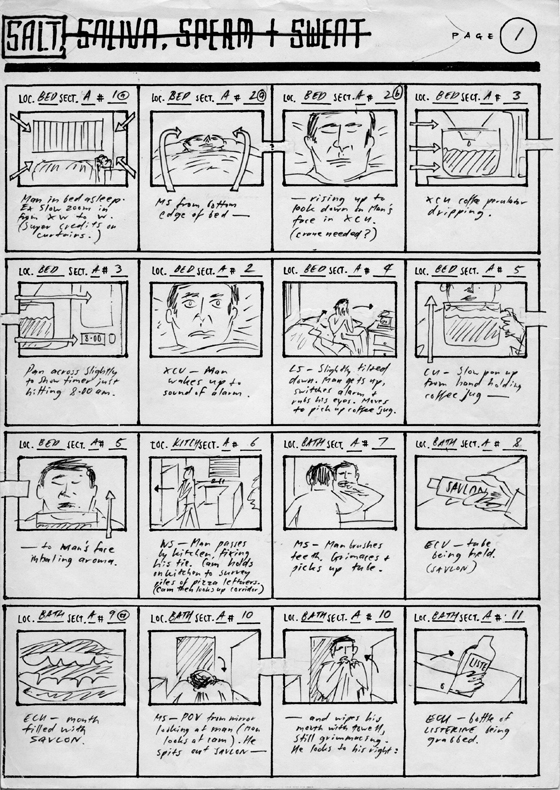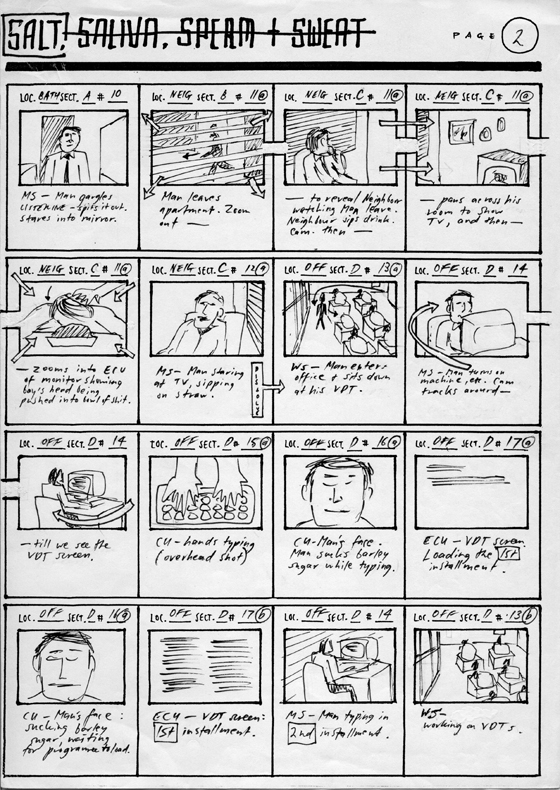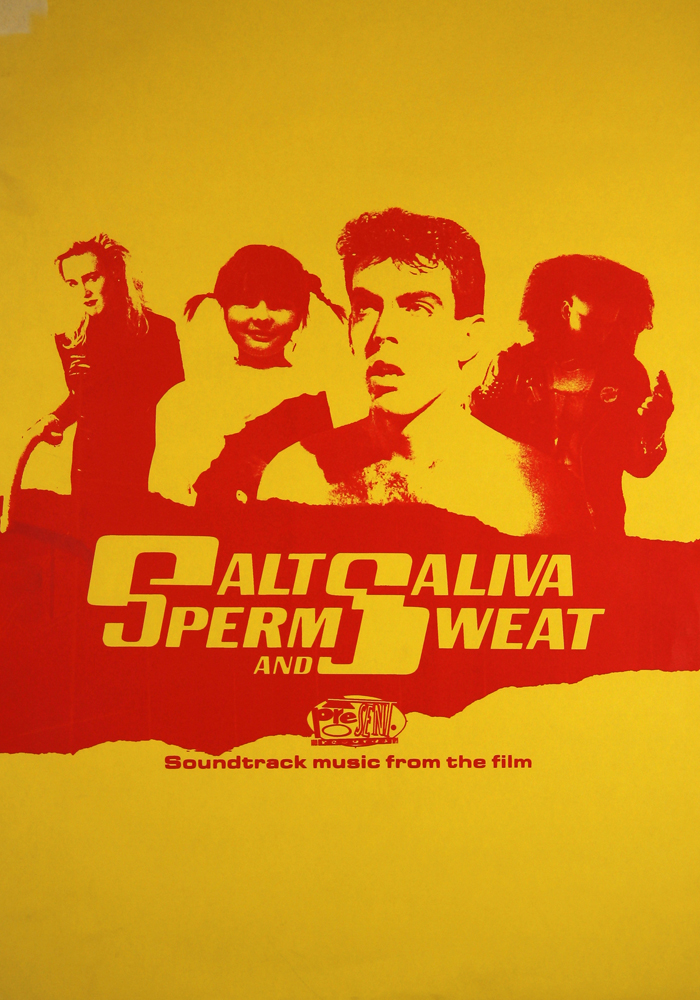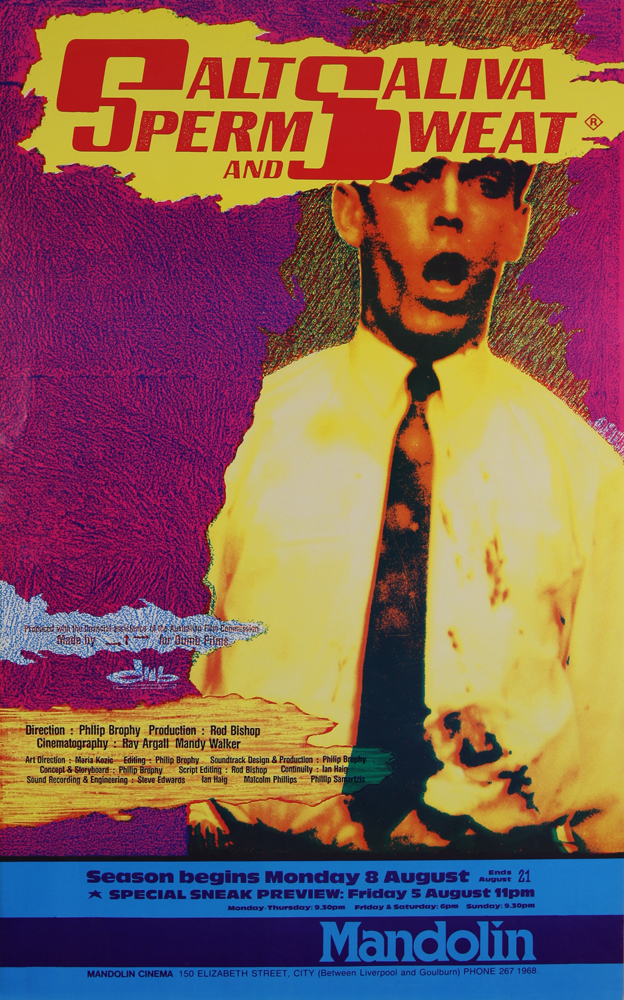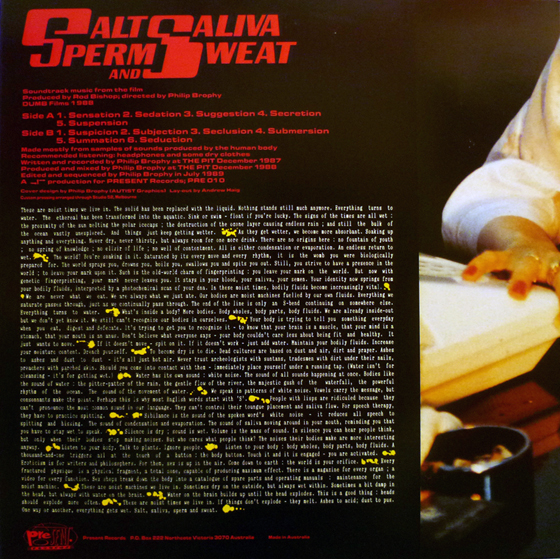Background
From the start, the sound design for Salt Saliva Sperm & Sweat was envisaged as a visceral aural onslaught. The sound needed to be pornographic in its bodily presence, unrelenting in its audio-visual dominance, and hyper-tactile in its detail and performance. No need to subjugate sound to image here: each would attain a parallel weighting of 100%. The influences were the approach to post-dubbed audio in the infamous spaghetti westerns, the assaultive of sound effects in classic Warner Brothers cartoons (Coyote/Roadrunner, etc.), the phantasmagorical aural mash-ups of modern horror & gore movies, and the hyperventilating guttural collapse of meaningful dialogue in hardcore pornography. Superficially, one could read this as a reliance on ‘violence’ in the film soundtrack, but the position staked in Salt Saliva Sperm & Sweat is that ‘normal/normative’ films’ soundtracks deliberately suppress, contain and debilitate this magnified sonic energy in service to the comparatively staid niceties of quality chamber dramas.
Credits
Soundtrack design, production & mix - Philip Brophy
Foley performance - Philip Brophy
Sound recording & engineering - Steve Edwards, Ian Haig, Malcom Phillips & Phillip Samartzis
Music composition, production & mix - Philip Brophy
2016
"Sedation" included on the compilation MIDNITE SPARES, Efficient Space Records, Sydney
1989
Soundtrack LP released through Present Records
1987
Recorded & mixed at Phillip Institute of Technology
Overview
Sound Design
With unabashed glee, production of the soundtrack proceeded to construct a 'hyperbody' to match the 'everyman' in the film's repetitive daily narrative. This was partly in the conceptual spirit of the film, but partly in order to experiment with pushing the sound design to an extreme. All the Foley sounds were recorded with 8 microphones: 2 at my feet, 2 at my chest (for fabric rubbing) 2 at my hands (placed over a table, for holding/fondling props) a mono mic pointed at my mouth (for breathing/etc.) and a stereo binaural headset in my head to record an overall spatial capture of my body doing all these actions. These 9 channels of audio were recorded live into a 2-track submix on the 8-track recorder.
Of the remaining 6 tracks, 4 were for sound effects, and 2 were for the music score. Most of the sound effects were recorded live as Foley, requiring a specific 2-mic configuration for recording each sound effect. In special cases (like the guy shot) a multi-track sound effect was constructed which was then mixed down into stereo, and played back on a Nagra reel-to-reel deck – having the sound cued and paused, then letting it play in synch with the on-screen action. In other words, no time-code was used for the whole film, as multi-track time-coded audio post-production was a resource beyond the capabilities and budget of independent filmmaking in 1987. The standard practice was to produce everything in sections on 4 or 6-track 16mm editing benches, which would then be employed for final mixdowns at film laboratory mix suites. (But which, as mentioned, would not suffice for producing a hi-fidelity stereo soundtrack.) As mentioned below in the Technical section, the film was broken down in 22 discrete segments, each of which was worked on a continuous passage of sound. When the 8-tracks for each of these sections was complete, the mix for each of the 22 segments was done completely live. Detailed sound charts functioned as a score for all the volume changes, panning, punching-in/out to be done in the one pass, often with two people operating the mixing desk.
Music Score
If the score for Salt Saliva Sperm & Sweat sounds repetitive, it’s because the whole score is based on then single rhythm: ba / ba-ba-ba / ba / ba. This is literally the pattern of saying the film’s title: salt / a-li-va / sperm / sweat. This was laid down as a base track with a programmed Boss drum machine.
For the various ‘themes’ of the music score, bodily sounds (slaps, hits, rubs, coughs, etc.) were digitized into an SPX effects box, which allowed one to temporarily store up to 2 seconds of audio. I could then route the audio of the drum machine track to trigger the stored sample, and have it ‘spit out’ the sound in rhythm. By altering the signal level going into the SPX, different counter-rhythms could be generated and recorded onto separate tracks of the 8-track, always staying in synch wit the original drum machine track. Around 10 themes were developed this way, each layered from vocal and body samples, as well as other percussive props used in recording then film’s numerous Foley tracks. Thus, the ‘music score’ is texturally composed of the aural fabric of the film’s sound design. Of the 20 tracks composed, only 2 retain the original drum machine track. On about half of the tracks, tones from a DX7 synthesizer are combined.
The music score for Salt Saliva Sperm & Sweat comprises 10 themes. Each relates to a key action within the man's daily narrative. These 10 themes are modified for each of the film's 4 sections.
Technical
Synchronization & Stereo Post-Production
Having worked with hi-fidelity stereo and multi-channel audio in numerous early → ↑ → videos, the shift to working in 16mm optical film was bound to be perplexing. By the late 80s, VHS tape playback incorporated Hi-Fi audio (a proto-digital form of audio encoded onto a discrete pathway of the magnetic VHS tape). The soundtrack for the 16mm version of No Dance (1985) was produced first in stereo, and then a mono mix was submitted to the laboratory for making the optical neg for the soundtrack. This was in preparation for having a hi-fidelity audio video version of the film, but it was achievable mainly because there is no visible synch-sound in that film (no on-screen talking, etc.). Salt Saliva Sperm & Sweat was not only much longer, but it was full of synchronous sound – some dialogue, but mostly a surfeit of Foley work (footsteps, hands holding objects, bodies generally making noise, etc.) – all of which was continuously visible on-screen.
The intention with Salt Saliva Sperm & Sweat was to – as with No Dance – produce the sound in stereo, then conform a mono mix for the 16mm optical neg. First, a synch test was conducted. A clear strip of celluloid was marked every 24 frames with a large red mark. The duration of the strip was 5 minutes. This was then attached to a count-down leader, and projected in the studio. I performed a drum tap in-synch with the flashing red marks, recording the audio onto an 8-track ¼’’ reel-to-reel tape machine. This was then mixed down to a ½-track ¼” reel-to-reel tape machine, which was then sent to a film laboratory to be transferred onto 16mm sprocketed mag tape. The mag tape was laced onto a 16mm editing bench, aligning the tape head with the start of the clear sprocketed celluloid. I then noted how long it was before the drum taps went out of synch with the red marks on the celluloid strip: around 2 minutes.
This test gave me the technical confidence to proceed doing the film’s sound design and mix in full stereo using this system. After completing charting the sound design for the finished edit of the film (noting the required spot sound effects, atmospheres, and multiple layers of Foley in every shot), I gauged where I could make clean cuts between scenes, ideally breaking the while film down into 22 segments under 2 minutes in length. This was so that each section could be recorded and mixed discretely, then tightly positioned in the master 16mm mag edit (joining all the segments) in perfect synch with the edited film.
The edited film was then broken down into these 22 segments, each with a countdown at its head, followed by black at its conclusion. These sections were telecined at 24 frames a second (not the standard 25 fps for video post-production) and played back on a monitor in the studio. This allowed me to record all the audio in preparation for it being transferred at 24 fps for the final optical soundtrack. (When a final Hi-Band U-Matic video master was produced, the audio was pitched up match the video synch.)

